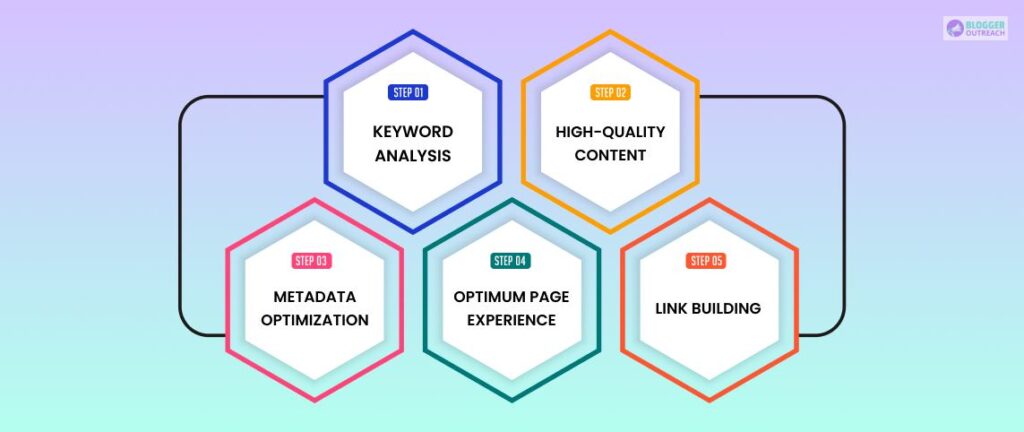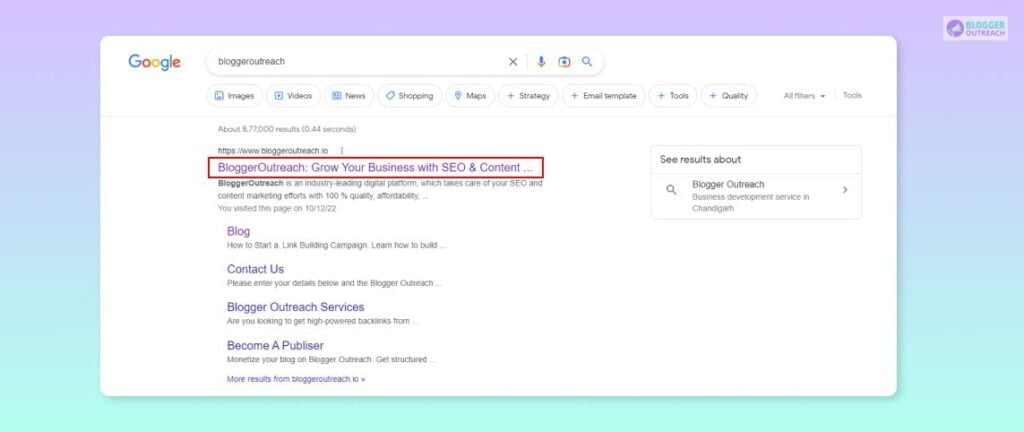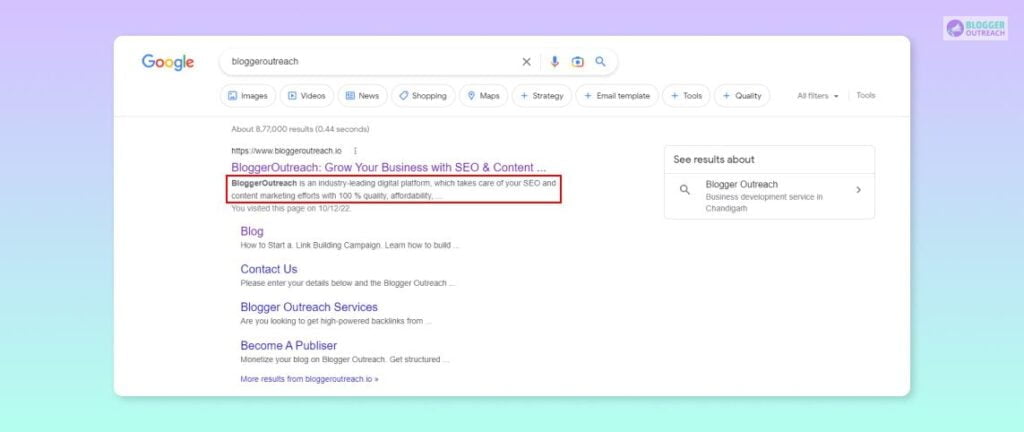Two out of three people never move beyond the Search Engine’s first page!
What does that mean? It implies that when it comes to scanning answers for our queries, we want quick results. This is why you need to rank on the first page of the search results to gain visibility.
If you rank within the first page of search engine results, the chances that your prospect will be introduced to your content are much higher. This is where SEO comes into the picture.
To boost your traffic and improve your visibility, SEO is inevitable. SEO is an umbrella that comes with numerous practices. Search engines use SEO to decide the ranking of the websites.
Here is the catch: The search engine result page is overloaded with content from numerous content creators. As there are different types of SEO, most people try SEO, but only a few get the desired visibility.
How can you stand out amongst your competitors and stay ahead of the curve? Worry no more! In this article, we will delve deep into the different types of SEO and the top 5 best practices of SEO that can give you proven results.
Table Of Content
Significance Of SEO

SEO or search engine optimization is the vehicle through which you try to rank higher on search engine results. There are different types of SEO strategies that can help you with this. We will discuss those later in this article. Prior to understanding the more complex aspects of SEO, let’s see why SEO is important:
- Ranking Decider – SEO is the mechanism that helps your website to rank higher on search engine result pages. If you follow the best practices of SEO that are in line with Google’s policy, there is a higher possibility that you will rank higher and garner more traffic.
- Boost Your Traffic – The more you get visibility, the better the chances of getting traffic. As SEO improves your rank, and that will help you to attract a constant flow of traffic.
- Augments ROI – Given the lower cost involved, the results of an effective SEO strategy are lucrative. It is one of the most lucrative organic means that boost your sales in a cost-effective manner.
- Brand Awareness – At this point, we all know that the perks of practising SEO are higher ranking and traffic. Now it’s common sense that website traffic and your brand’s presence go hand-in-hand.
- Improves Credibility – Imagine you have followed the best SEO tactics, and now people are visiting your website. Now, your content decides whether people will consider you a credible source of information. If you write quality content that adds value to your readers, chances are higher that, with time, they will consider you an industry leader.
Different Types Of SEO

You can perform SEO in numerous ways. Let’s look at ten different types of SEO that you can consider.
1. On-Page SEO
On-page SEO focuses on the factors that are within your websites and in your control.
The Most Common On-Page SEO Strategies Involve The Following
- Keyword Placement – You place your focus keyword tactically throughout the entire article without putting it forcefully.
- Quality Content – Your content must successfully address the users’ query. Most importantly, it should meet the search intent of the user.
- Optimizing Your Title Tags -Title tags tempt people to click on your article. Keep it crisp, add keywords, and try to write unique titles.
- Optimizing Your Meta Description – Writing engaging meta descriptions is important to influence Google’s traffic. Add a focus keyword, include a keyword, and end with a crystal clear call to action.
- Headlines – Headlines are important to structure and organize your content. Google uses headlines to understand the order of your content.
- Page Speed And Website Experience – Loading speed is among the most important ranking factors. You should find the means to provide the optimum user experience.
- Image Optimization – Alt texts are the popular way of optimizing your images. Alt texts are HTML code that helps the search engine understand the image’s context.
Changing URLs:
2. Off-Page SEO
Off-page SEO involves practices that are beyond your website. In comparison to on-page SEO, off-page SEO considers the external factors that are outside of your website.
Off-Page SEO Strategies Include
- Guest Posting – When you write for fellow websites and get inbound links to your website, you’re doing guest posting. The inbound links redirected to your website are backlinks. Guest posting boosts traffic, improves brand awareness, builds credibility, augments sales, and more.
- Blog Commenting – It is sharing a comment below your blog. Comments from industry-recognized individuals help you gain credibility, boost traffic, build backlinks, improve social shares, build relationships, etc.
- Forum Submission – Here, you join prominent communities and share your expertise. If people are satisfied with your answers, they visit your website, which, in turn, boosts your traffic.
- Broken Link Building – The fixing of broken links is quite relevant today! Here you can look for industry-recognized blogs with ‘404 broken links’. Once you find any of those, you pitch them to replace the link with the one driving to a relevant page on your website. This is how a link-building strategy works.
- Collab With Influencers – Collaborating with influencer bloggers and individuals with high-traffic websites can help you tremendously. If they link their content to your website, it will drive high traffic.
3. Technical SEO
Technical SEO is all about optimizing the technical facets of your website and ensuring that your website meets the technical requirement. Among different types of SEO, technical SEO is mostly essential for crawling and indexing.
Crawling is when a search engine deploys a bot following the links and web pages to search the updated content on the web.
When a search engine completes the crawling process, it organizes and stores all the updated content. This is indexing.
Technical SEO Comes With The Following
- Here you fix all the internal and external broken links.
- Ensuring your site is crawlable and indexable.
- Uncovering crawl error through crawling.
- It helps in content gaps and improves content quality.
- It also discovers the missing title tags, lengthy meta descriptions, and ALT tags.
- Secure your website with HTTPS.
- Make your website mobile optimized.
4. White Hat SEO
When you abide by the terms and policies of search engines, you follow white-hat SEO practices. White hat SEO is morally right and done keeping the readers’ well-being in mind. It is one of the most popular types of SEO that helps in ranking.
Some Of The Popular White Hat Techniques Are
- Strictly adhering to the terms and policies predefined by search engines.
- Understanding the search intent of the reader and ensuring your content meets the search intent.
- Providing an optimum user experience with fast loading speed.
- Value-rich content with correctly placed keywords in title tags, meta tags, and the body of the content.
- Acquiring quality links from authoritative websites.
Following the best practices of white hat might save your website from getting penalized.
5. Black Hat SEO
Among different types of SEO, Black hat SEO is an unethical way of ranking higher on search results. Here you don’t pay heed to Google’s terms and policies.
The Advocates Of Black Hat SEO Mainly Focus On The Following
- In search of quick results, people indulge in keyword stuffing by over-emphasizing a specific keyword without understanding its context.
- They use hidden texts that automatically redirect you to another website that they want you to visit.
- Here people copy content from their competitors’ websites and replicate it.
- Black hat SEO doesn’t consider content quality. So here the content doesn’t meet the search intent.
- Black hat SEO advocates buy and sell links in search of quick traffic.
- Here people spam the comment box to manipulate the search engine.
Black hat SEO is a short-term game. Once search engines like Google discover that your site is following black hat practices, it will penalize your site.
6. Grey Hat SEO
Grey hat SEO combines two different types of SEO – white hat SEO and black hat SEO. It is safer than black hat SEO but riskier than white SEO. Here it is not certain that the search engine will penalize your site. It may happen or may not occur.
Grey Hat SEO Habits Come With The Following
- Purchasing Expired Domains – It is all about buying parts that are inactive or not renewed. People usually purchase high-authority domains or established domains to attract traffic.
- Smart Keyword Stuffing – This is more about placing your keywords carefully. Here you incorporate keywords with perfect keyword density to attract traffic.
- Social Media Manipulation – many people buy followers to gain a presence on social media. Therefore, improving the follower count helps them to garner traffic to their website.
- A Private Blog Network – PBN is a network of websites that links to each other to gain traffic.
7. Mobile SEO
Mobile SEO aims to optimize the website’s content and elements targeting mobile users. You ensure that your website performs seamlessly on mobile phones and provides an optimum user experience.
Why Is Mobile SEO Important?
- In the current era, more people are surfing the internet from the comfort of their mobile phones.
- If you do not optimize your website for mobile, there is a high possibility of creating an ill impact.
- With every algorithm update, Google is giving more priority to mobile-friendly websites.
Mobile SEO Best Practices
- Visually attractive UI/UX design.
- Improving the page loading speed and serving optimum user experience.
- The user experience should be your ultimate priority.
- Make sure it doesn’t take up your entire mobile screen when it comes to pop-ups.
- Provide seamless navigation, so the users don’t have difficulty accessing the necessary information.
- Create a separate mobile URL that can give a personalized user experience.
8. Ecommerce SEO
Ecommerce SEO is the mechanism that helps online stores to acquire traffic, boost sales, and improve their online presence.
There are two goals of ecommerce SEO. The qualitative approach comes with the page loading speed, website experience, content quality, etc.
Hacks To Leverage Ecommerce SEO
- Put yourself in the buyer’s shoes; if you were the buyer, what keywords did you search for? Long-tail keywords help more in understanding the search intent.
- Analyze your competitors and decide the keywords based on popularity and buying intent.
- Optimize your product page with all the necessary information.
- Try to provide an optimum website experience with a fast loading speed, easy navigation, and seamless information searching.
- Start with blogs and attract traffic to your website.
- Write unique product titles and descriptions and stay away from duplicate content.
9. Local SEO
Local SEO is when you target users within a specific city or area. It aims to improve your product’s organic reach and visibility within a particular location. The perk of local SEO is that customers can easily find, evaluate and take action on your product or services.
How To Execute Local SEO For Business?
- Create your Google business account and add the necessary details – business name, phone number, website, company address, hours, and more.
- Remember that Google determines local SEO rankings based on relevance, distance, and prominence.
- Try your hands with keyword research and list out the local keywords.
- Ask your customers to add reviews, and try to manage them.
10. Negative SEO
Negative SEO is the technique of outperforming competitors’ search rankings by using unfair means. The attackers are maybe your competitors or someone who doesn’t want you to experience growth.
Given the nature and strategies involved, we mostly consider negative SEO under black hat SEO.
Negative SEO Tactics
- Copying content from competitors’ websites and using them.
- Hacking a website to hamper the website’s rank negatively.
- Many people post meaningless fake reviews to hammer the reputation of their competitors.
- Several instances where attackers add spammy backlinks redirected to your website.
- In many cases, spammers send fake backlink removal requests to websites. Here the goal is to get rid of your backlinks.
5 Proven Ways To Increase Traffic Through SEO

When it comes to boosting your traffic, you may find different types of SEO tactics around the web. But here we will talk about the top 5 tested ways. Here you go:
1. Keyword Analysis
Extensive keyword research is the first step of any successful SEO effort. Keywords are the exact search phrases people write to enquire about something they don’t know or buy any product or service.
The focus keyword is the backbone of your content. Your content revolves around your focus keyword. In contrast, long-tail keywords are search phrases that consist of 3-5 words. Long-tail keywords are more accurate in analyzing the search intent of the user.
Relevant Keywords Identification
- Topic Listing: Analyse the topics you feel your niche audience is more likely to read. List out the topics and search for keywords.
- User Intent Analysis: Before building any keyword strategy, you inevitably know the user’s search intent. Analyze why someone might be searching for this keyword.
- Seed Keywords: It is the first step of keyword analysis. Imagine you’re a car seller; your seed keyword is sports cars, SUVs, off-road cars, etc.
- Competitor Analysis: Check out the keywords that your competitors are ranking. Once you have the list of competitors, you can check for their traffic and search volume and decide which keyword performs the most.
- Monthly Search Volume: It refers to the average number of monthly searches for a specific keyword. Several tools can help you with this, Google’s most popular keyword planner.
- Keyword Difficulty: It helps you to gauge how difficult it is to rank for a specific keyword.
2. High-Quality Content
Write for readers, not for the search engine!
When we talk about quality content, we mean authoritative, problem-solving content. Consider your content as your business and address your readers’ pain areas. Quality content is pivotal for higher search engine rankings. And holds true for all the different types of SEO.
Here Are The Ways How You Can Leverage Your Content For SEO
- The Goal Of Your Content: The purpose of your blog must be clear to you. The writing style depends on the end goal of that specific blog. For example, some blogs are for sharing information, and some are for building links, etc.
- Readers’ Persona: You must know whom you’re talking to. Understanding the readers’ pain areas and expectations is the surefire way to leverage your content.
- Don’t Fake Your Knowledge: Write about something that you’re master at. You must possess the required expertise to talk on specific topics. If you need to learn about a particular niche, study well, acquire expertise, and start writing.
- Extensive Research: Thorough research is crucial for creating a thought-provoking blog. Analyze the competitors’ blogs and figure out the loophole. Then, consider how you can outperform your competitors and frame your content accordingly.
- Accurate Keyword Placements: Contextual keyword placement is the hack to an SEO-friendly blog. Place your keyword in the headline, meta tags, and throughout the content. Don’t indulge in keyword stuffing by over-emphasizing a specific keyword.
- Problem-Solving Content: Tap into the pain points of your readers. Curate your content to educate the readers by addressing all the necessary queries.
3. Metadata Optimization
Search engines like Google collect information from your website and determine how to display your website. In simple terms, metadata is your website’s highlights that tell search engines what your website is all about.
Optimizing your metadata boosts your ranking and enables you to get more traffic for all types of SEO.
There Are Three Types Of Metadata
- Meta-Titles:

It is responsible for your web page’s ‘displayed title.’ Check out what it looks like: You must add the focus keyword in your meta title and optimize it.
- Meta-Descriptions:

The meta description appears below the meta title on the search engine result page to showcase the essence of your article.
- Meta-Keywords:
Meta keywords are not visible to the user. Instead, search engines discover meta keywords to understand which keywords your website is optimized with.
4. Optimum Page Experience
Do you know that optimum page experience can fetch a lot of traffic to your website? Yes, you read that right! Google is continuously upgrading its algorithm and metrics to gauge page experience.
You can call page experience a package of signals used by Google to determine websites with optimum user experience.
Google’s Page Experience Signals Are As Follows
- Core Web Vitals:
Google is relentlessly striving to make users elated through its website experience. In 2020, Google launched the core web vitals to serve the same purpose.
Core web vitals come with three metrics. These are:
(i) Largest Contentful Paint (LCP) – It signals to Google how long your website takes to load the largest content element. The largest component could be an image, or it could be a text. According to Google, a good website must have LCP within the first 2.5 seconds.
(ii) First Input Delay (FID) – Interactivity is the key parameter for FID. It gauges how long a browser takes to interact with a user when they land on your website for the first time. As recommended by Google, the ideal FID is 100 milliseconds.
(iii) Cumulative Layout Shift (CLS) – It focuses on stability. It analyses, while loading, how stable your page elements are. Have you ever tried to read specific stuff on a website or tapped a button and ended up clicking something else? If yes, then you’ve already witnessed what CLS is. For optimum website experience, Google recommends having a page experience of less than 0.1.
- Mobile-Friendly:
We all know that mobile users are increasing day by day. As the number is growing daily, Google has started prioritizing mobile-friendly websites for ranking.
Perform a mobile-friendly test and evaluate your website. If there is room for improvement, go for it.
- HTTPs:
Are you using a secured connection? Secure your website with HTTPS. If you haven’t confirmed your page with HTTPS, do it.
5. Link Building
You may find numerous types of SEO tactics, but Link building is acquiring inbound links from fellow websites redirected to your website. These inbound links are known as backlinks.
Backlinks from high authority websites act as a trust signal to Google. Therefore, the more you get backlinks from a high authority website, the better the chances of getting higher traffic.
In addition to getting traffic, backlinks also help you to improve your credibility, improve brand awareness, and indirectly boost your sales.
- Link-Building Process
(i) Link Identification – You can’t put any random link for ranking higher. Instead, you need to identify the credibility of that specific link. The credibility of a link depends on two factors, relevance and source prominence.
Make sure the source website is relevant to your niche. For example, it’s pointless if you’re writing a relationship blog and acquiring links from cooking niches.
And please check the website you’re collaborating with is recognized within your industry.
(ii) Link Placements – Make sure your links are in sync with the content. Place your links seamlessly throughout the content. Refrain from placing them forcefully while reading. It should give you a natural feel and doesn’t disrupt the flow.
Make sure the source website is relevant to your niche. For example, it’s pointless if you’re writing a relationship blog and acquiring links from cooking niches.
And please whether the website you’re collaborating with is recognized within your industry.
Are You Ready To Master The SEO Game?
At this point, you get an idea of how SEO works. However, as there are different types of SEO in the content marketing world, please ensure that you follow the right practices.
As Google constantly changes its algorithm, you must be flexible to adapt to those changes. Always remember that a successful SEO strategy requires some patience. And don’t pay heed to different types of SEO myths.
You can opt for different types of SEO services if you don’t have the time to do it yourself. Then, believe in the process and keep faith that you’ll be able to ace this SEO.
We hope that this article will bring spark your SEO efforts. If you have any doubts, feel free to contact us.
Read Also:









